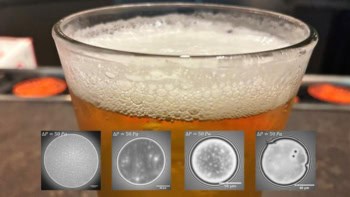
The cover feature of the September 2014 issue of Physics World, which is out now in print and digital formats, concerns “sterile neutrinos” – a hypothesized fourth kind of neutrino in addition to the familiar electron, muon and tau neutrinos. Sterile neutrinos are controversial – they have never been detected and we are not even sure if they exist at all. But if they do, sterile neutrinos could potentially solve a raft of unsolved problems in physics, including why neutrinos themselves have mass, what makes up dark matter and why there is so much more matter than antimatter in the universe.
In the article, you can find out more about the mysteries these hypothetical particles could solve. But since they might not exist, why – you may wonder – would anyone bother looking for them? In other words, is the search for sterile neutrinos pointless or profound? Check out the September issue to find out more.
If you’re a member of the Institute of Physics (IOP), you can now enjoy immediate access to the new issue with the digital edition of the magazine. If you’re not yet in the IOP, you can join now to get full access to Physics World as well as many other member benefits.
For the record, here’s a run-down of other highlights of the September issue.
• Peering through the fog – Scientists in China have revealed ambitious plans to construct a huge smog chamber to help combat the nation’s worsening air quality. But as Ling Xin reports, some are unconvinced that it will make a difference.
• Building bridges with art – With mathematicians having an annual get-together to talk about maths and art, Pangratios Papacosta argues that it is time that physics follows suit.
• The right questions – Robert P Crease discusses a book by a theoretical-physicist-turned-philosopher that seeks to upend some long-standing views.
• A fourth type of neutrino – If disappointments continue at the high-energy frontier, you might be hearing a lot more about the sterile neutrino, says Jon Cartwright.
• Einstein’s steady-state cosmology – Last year, a team of Irish scientists discovered an unpublished manuscript by Einstein in which he attempted to construct a “steady state” model of the universe. Cormac O’Raifeartaigh describes the excitement of finding this previously unknown work.
• Fantasy physics for nuclear testers – In November a group of scientists will scour a small patch of the Middle East for signs that a nuclear explosion has taken place. Edwin Cartlidge describes their delicate mission and the sophisticated gadgetry they will rely on in this giant role-playing game.
• A space cowboy’s tale – James Dacey reviews the film The Last Man on the Moon, directed by Mark Craig.
• A classy look through mathematics – Dean Burnett reviews Alex Through the Looking Glass: How Life Reflects Numbers and Numbers Reflect Life by Alex Bellos.
• Leadership required – What does it take to lead a lab with more than 2000 staff
members and an annual budget in excess of €800m? As CERN celebrates its 60th anniversary this month, Sharon Ann Holgate finds out what’s expected of the lab’s next director-general.
• Once a physicist – meet entrepreneur, politician and founder of Next Big Thing Chris Philp.
• Lessons of the Angry Birds universe – in this month’s Lateral Thoughts, Rhett Allain looks at the physics of the most popular smartphone apps.



